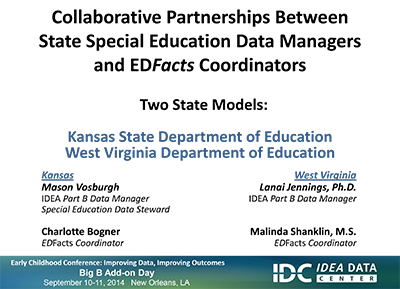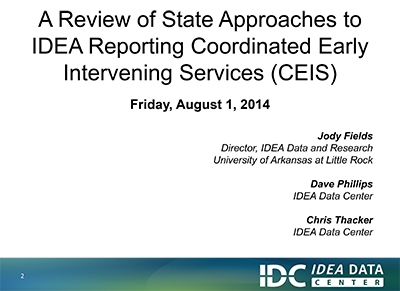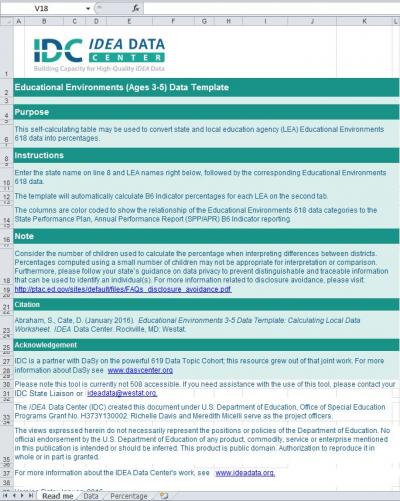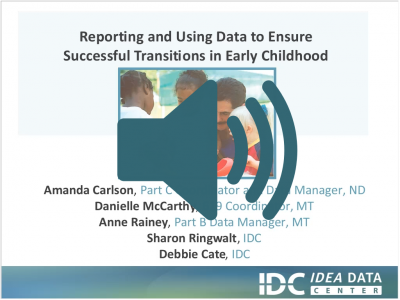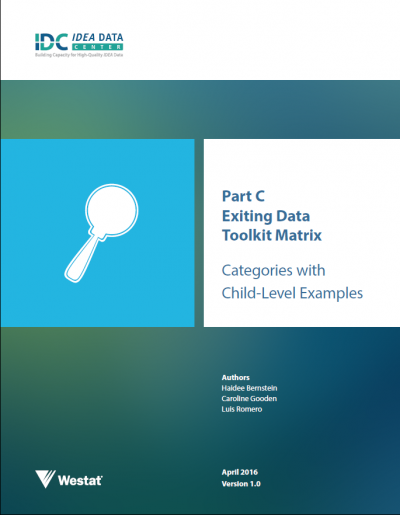Site Search
Results 8 - 14 of 41
Format: Presentations
Collaborative Partnerships Between State Special Education Data Managers and EDFacts Coordinators: Two Models-Working Together to Make a DifferenceThe presentation outlined the collaborative partnerships between the Part B data manager and EDFacts coordinator in two states--West Virginia and Kansas. The discussion included a range of topics from collaborating on data collection and verification at the LEA level to SEA EDFacts submissions. The presentation included time for other Part B data managers to share strategies for successful submission of their 618 data through EDFacts.
Format: Presentations
A Review of State Approaches to IDEA Reporting Coordinated Early Intervening Service (CEIS)IDEA allows, and sometimes requires, LEAs to use funds provided under Part B of IDEA for CEIS for students who are not receiving special education services. There are multiple data collection and reporting requirements associated with the use of these funds for CEIS. IDC staff review how a diverse subset of states and their LEAs are working to meet those requirements. Both aggregate and student-level reporting approaches are reviewed.
Format: Toolkits and Templates
Educational Environments 3-5 Data Template: Calculating Local Data WorksheetThis data template provides SEAs and LEAs the opportunity to see in real-time the percentages of their children ages 3-5 attending and receiving services in specific educational environments. When the LEA 618 educational environments data is simply entered on the data tab, the percentages will be calculated and displayed on the percentage tab. The use of this tool will allow SEAs to compare the percentages of children within educational environments across LEAs.
Format: Presentations
Public Reporting of Section 618 Data: Regulations, Processes, and PitfallsIDEA requires that states publicly report Section 618 data. To assist SEA special education directors and data managers in meeting these requirements, IDC is developing a TA tool to simplify regulatory language and requirements into one document that includes process tips and pitfalls. The presentation highlighted existing practice across the country and provided opportunity for attendees to review the current draft of the proposed TA tool.
Format: Recordings
Reporting and Using Data to Ensure Successful Transitions in Early Childhood WebinarThis webinar highlighted the IDEA state reporting requirements for early childhood transitions for both Part C and Part B, found in the SPP/APR Part C Indicator 8 and Part B Indicators 11 and 12. Participants shared resources related to transition, data collection, and reporting, as well as the use of both Part C and Part B data to facilitate high quality transitions. North Dakota's Part C coordinator and data manager and Montana's 619 coordinator and data manager described how their states collect and use transition data to ensure smooth transitions for all young children as they turn three and move from early intervention services to preschool 619 services.
Format: Checklists, Crosswalks, and Rubrics
Part C Exiting Data Matrix: Categories with Child-Level ExamplesThis matrix is both a standalone product and the fourth section of the IDEA Data Center Part C Exiting Data Toolkit. It contains scenarios for each of the 10 exiting categories. The Part C Exiting Data Toolkit is designed to assist states in reporting high-quality Part C exiting data, required under Section 618 of IDEA. The remaining three sections in the Part C Exiting Data Toolkit are: Part C Exiting Reasons and Categories (Section 1); General Challenges and Potential Solutions (Section 2, Part 1); Specific Challenges, Potential Solutions, and Variation (Section 2, Part 2); and Data Check Patterns and Additional Data Check Patterns to Ensure Non-Duplicated Counts of All Eligible Exiting Children (Section 3).
Format: Recordings
Annual Report to Congress on Implementation of IDEA WebinarThe webinar featured the purpose and history of the Annual Report to Congress on the Implementation of the Individuals with Disabilities Education Act, its current organization and content, links to the report and its data sources, and suggestions for how participants can use the report. The webinar was designed so that participants would have a greater understanding of why it is important to work to improve the quality of IDEA-related data by seeing how the U.S. Department of Education uses IDEA data to meet an annual statutory requirement to report to Congress;. In addition, it was designed to help participants become familiar with a key resource on state and national IDEA data and related information and prompt them to think about how they might use the resource.

